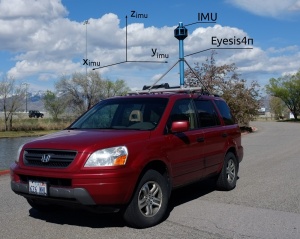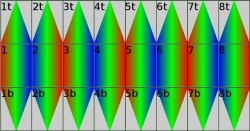Eyesis4Pi 393
Contents
Status
Available
Overview
Elphel Eyesis4Pi-26-393 is the newer generation of the full-sphere multi-camera systems for stereophotogrammetric applications.
Automated panoramic imagery and 3-dimensional panoramas are the 2 main applications of Eyesise4Pi-393 camera. * Car and backpack mounts are not included. Improvements over the earlier generation Eyesis4Pi
|
Features and Specs
- 4*π (360x180) full sphere coverage
- 64 MPix panoramic image resolution after stitching
- Final panoramic image equirectangular projection dimensions - 14000x7000
- 0.05 Pix stitching precision
- Very small parallax - distance between entrance pupils: 46.5 mm
- High resolution lenses: 26x M12 lens mount
- Calibrated fixed lens to compensate for the lenses distortions
- 10" (0.1 pix) in the center 80% x 80% area
- 30" (0.3 pix) maximal error over the full FoV
- <0.03um/° thermal expansion
- Precise image capture synchronization
- 5 FPS - maximum frame rate
- RAW or compressed image formats
- Images are geo-tagged (Exif) - 5Hz GPS receiver (Locosys LS20031)
- High-precision IMU ADIS 16375
- Recording to:
- internal SSDs - not swappable - 3x m.2 SSDs (physical size: 2242 or 2260)
- external SSDs - swappable - 3x 2.5" SSDs connected in a hot swap rack
- PC over network
- Web Based GUI
- SYNC cable allows:
- receive and log external trigger (from a sensor such as odometer or extra GNSS system)
- generate output signal to trigger other sensors or cameras
- Weatherproof camera body and camera pole
- Dimensions: 230x760 mm (9x30")
- Weight: 8 kg (18 lbs)
- The Eyesis4Pi-393 system is highly customizable
- Free Software and Open Hardware
Operation
- The system is controlled from a laptop via a web-based interface (Eyesis4Pi GUI). Which also displays real-time previews and parameters.
- Power consumption is about 50W.
- Power supply:
- AC/DC power adapter (input: 110V/220V, output: 48V 2A) and can be used with a car power adapter (inverter), when mounted on a car roof.
- 48V batteries (48V 4Ah - about 1h of operation)
Calibration
We have developed full calibration process and post-processing software to compensate for:
- Optical aberrations, allowing to preserve full sensor resolution over the camera FoV.
- Distortions – for precise pixel-mapping for photogrammetry and 3D reconstruction.
The calibration is performed using the machine (goniometer) that rotates the camera about 2 axes by precisely known angles. To calibrate IMU one needs to match the goniometer angles with the IMU data.
Check out these articles for more details:
Software
All software is FOSS (Free and Open Source Software). It is experimental software that is used to test the camera performance, and it continues to be developed. All updates are available for download and build from https://github.com. Software may require integration with customer software depending upon camera hardware configuration and application. It includes:
- Camera internal software/firmware and SDK
- Post-processing tools
- Calibration data
3D Model
|
More information
How to buy
We are directly accepting orders and ship worldwide. Please contact Elphel for Lead Time and Quotes:
- Email (Sales Inquiry): sales@elphel.com
- Phone: (801) 783-5555 x 107
- Toll-free: (888) 3 ELPHEL
- Fax: (801) 812-8267











